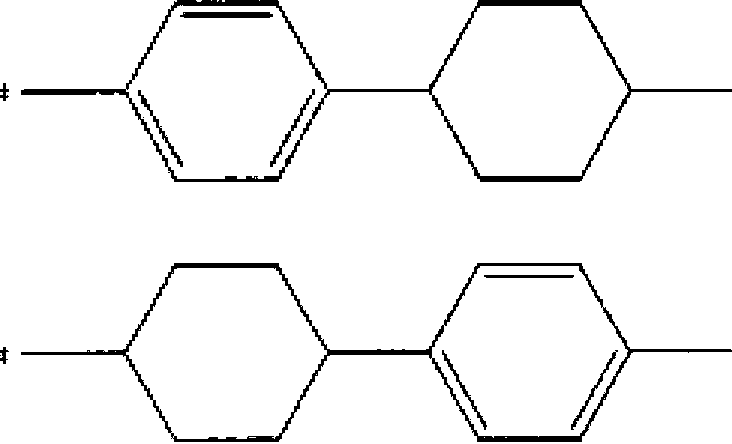Display material, liquid crystal alignment agent and liquid crystal display element
A liquid crystal alignment agent and display technology, applied in liquid crystal materials, instruments, chemical instruments and methods, etc., can solve problems such as uneven display and uneven ODF display, and achieve favorable product yield, excellent vertical alignment limit force, and high resistance. UV light effect
- Summary
- Abstract
- Description
- Claims
- Application Information
AI Technical Summary
Problems solved by technology
Method used
Image
Examples
example
[0574] Hereinafter, the present invention will be described more specifically by way of examples, but the present invention is not limited to these examples.
[0575] In the following examples, the weight average molecular weight Mw is a polystyrene-equivalent value measured by gel permeation chromatography under the following conditions.
[0576] Column: manufactured by Tosoh Corporation, TSKgelGRCXLII
[0577] Solvent: tetrahydrofuran
[0578] Temperature: 40°C
[0579] Pressure: 68kgf / cm 2
[0580]
Synthetic example S-1-1
[0582] Into a 200 mL three-necked flask equipped with a thermometer, 33.0 g of AC-SQ TA100 (a hydrolysis condensate of 3-acryloxypropyltrimethoxysilane, manufactured by Toagosei Co., Ltd.), 9.2 g of thioglycolic acid (with respect to AC -SQ TA100 has a silicon atom corresponding to 50 mol%), 42.3 g of acetonitrile, and 20.2 g of triethylamine, and reacted at 50° C. for 1 hour. After completion of the reaction, 195 g of a solution containing about 20% by weight of polyorganosiloxane (S-1-1) was obtained by substituting the solvent in the system with butyl cellosolve (BC).
[0583] Mw of this polyorganosiloxane (S-1-1) was 5,200.
[0584] Synthesis Example S-1-2 and Synthesis Example S-1-3
[0585] In the above Synthesis Example S-1-1, the amount of thioglycolic acid used was set as described in Table 2, and octadecanethiol in the amount described in Table 2 was further added at the time of charging. Example S-1-1 was carried out in the same manner to obtain polyorganosiloxane...
Synthetic example E-1
[0593] 250g (equivalent to 50mol %) and 3-methacryloxypropyltrimethoxysilane (MTMS) 252g (equivalent to 50mol%), methyl isobutyl ketone 502g as a solvent and triethylamine 50g as a catalyst, at room temperature down to mix. Next, after dripping 402 g of deionized water over 30 minutes using the dropping funnel, it stirred at 80 degreeC and reflux, and performed reaction for 6 hours. After the reaction, the organic layer was taken out, washed with a 0.2% by weight aqueous solution of ammonium nitrate until the washed water became neutral, and then the solvent and water were distilled off under reduced pressure to obtain a viscous transparent liquid Polyorganosiloxane EPS-1 with epoxy structure.
[0594] The Mw of this polyorganosiloxane EPS-1 was 2,900.
[0595] Synthesis Example E-2 to Synthesis Example E-4
[0596] In the above Synthesis Example E-1, except that the type and amount of the silane compound were set as described in Table 3, polyorganosiloxane having an epoxy...
PUM
| Property | Measurement | Unit |
|---|---|---|
| viscosity | aaaaa | aaaaa |
| viscosity | aaaaa | aaaaa |
| thickness | aaaaa | aaaaa |
Abstract
Description
Claims
Application Information
 Login to View More
Login to View More - R&D
- Intellectual Property
- Life Sciences
- Materials
- Tech Scout
- Unparalleled Data Quality
- Higher Quality Content
- 60% Fewer Hallucinations
Browse by: Latest US Patents, China's latest patents, Technical Efficacy Thesaurus, Application Domain, Technology Topic, Popular Technical Reports.
© 2025 PatSnap. All rights reserved.Legal|Privacy policy|Modern Slavery Act Transparency Statement|Sitemap|About US| Contact US: help@patsnap.com



